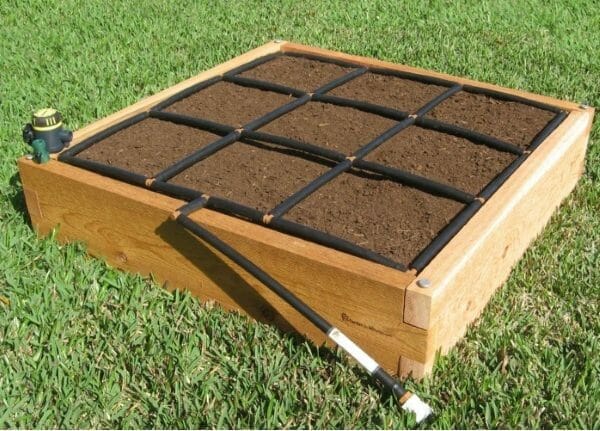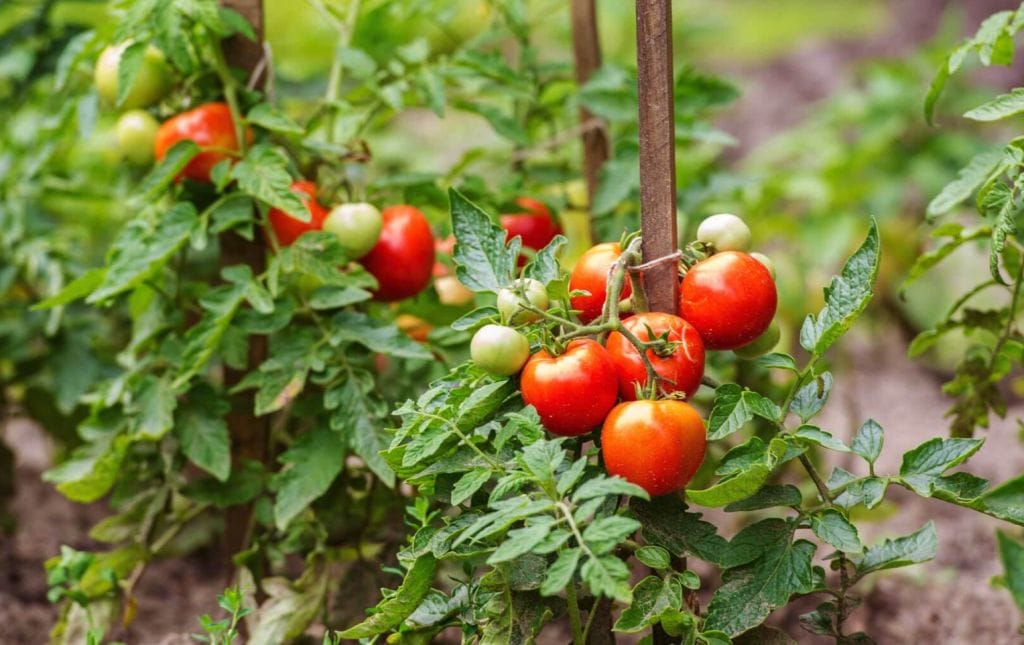How Many Tomato Plants in a 3×6 Raised Bed: Optimal Planting Guide

Growing tomatoes in a 3×6 raised bed can be fun and productive to enjoy fresh, homegrown produce in your backyard. When planting tomatoes in raised beds, one crucial aspect is the proper number of plants to ensure optimal growth and yield. With many factors to consider, such as the type of tomato plants and spacing requirements, you may wonder how many tomato plants in a 3×6 raised bed you should place.
Firstly, the type of tomato plants you choose plays a significant role in determining the number of plants you can fit into your raised bed. There are two main types of tomato plants – determinate and indeterminate. Determinate tomatoes grow to a fixed size and stop growing once they reach their mature height, while indeterminate tomatoes continue to grow and produce fruit throughout the season.
In a 3×6 raised bed, you can fit about 24 or 12 indeterminate tomato plants. Remember that proper spacing is essential for healthy growth and maximum yield. So, choose your tomato plants wisely, considering their growth habits and the ideal number of plants you can accommodate in your 3×6 raised bed for a successful and bountiful harvest.
Determining the Number of Tomato Plants

Size of the Raised Bed
When planning your tomato garden, the size of your raised bed is crucial. In a 3×6 raised bed, you have an area of 18 square feet to work with, providing room for many tomato plants. You must consider the space available, your desired tomato variety, and the plant’s growth habits to maximize your harvest.
Spacing Requirements
Proper spacing between tomato plants ensures healthy growth and an abundant harvest. Here is a general guideline for spacing based on the type of tomato plant:
- Small tomato varieties (such as cherry or grape): 12-18 inches apart
- Medium to large tomato varieties (like beefsteak or heirloom): 24-36 inches apart
Remember that spacing requirements vary slightly depending on the specific variety, so always refer to your seed packets or plant labels for recommendations.
Determinate vs Indeterminate Tomatoes
The type of tomato plant you choose also affects the number of plants you can grow in a 3×6 raised bed. Tomatoes come in two major categories: determinate and indeterminate.
- Determinate tomato plants: These plants have a more compact, bush-like growth habit and usually produce their crop simultaneously. A 3×6 raised bed will typically support 6-8 determinate tomato plants, with proper spacing.
- Indeterminate tomato plants: Also known as vining tomatoes, these plants continuously grow and produce fruit throughout the season. They require more room to spread out and develop. In a 3×6 raised bed, you can usually fit 4-6 indeterminate tomato plants.
Consider the size and spacing requirements of your preferred tomato plants, and choose between determinate and indeterminate varieties to plant happily in your 3×6 raised bed. With the right planning, you can enjoy a bountiful harvest from your tomato garden.
Growing Conditions and Requirements
Soil Quality and Composition
To successfully grow tomatoes in a 3×6 raised bed, you must consider the soil quality and composition. Tomatoes thrive in well-draining soil with a slightly acidic pH between 6.0 and 6.8. Your raised bed should have a depth of at least 12 inches to provide ample root growth and drainage space. Enrich your soil with organic matter, such as compost or aged manure, to enhance fertility and increase nutrient availability.
Sunlight and Temperature Factors
Tomatoes require optimal sunlight and temperature conditions to develop healthy fruits. Ensure that your raised bed is situated in a location that receives at least 6 to 8 hours of sunlight daily. The ideal temperature range for growing tomatoes is between 65 and 85 degrees Fahrenheit. The temperature should not drop below 50 degrees at night to prevent plant damage.
Watering and Fertilizing Needs
Proper watering and fertilizing are crucial to the success of your tomato plants. Water your tomatoes consistently, aiming for 1 to 1.5 inches per week, with more frequent watering during hot or dry periods. It is best to use drip irrigation or watering at the base of the plant to prevent foliage diseases.
Fertilize your plants with a balanced fertilizer or tomato-specific formula, following the package instructions. Begin by applying fertilizer at planting time and continue with regular applications throughout the growing season.
Support Structures and Pruning
Tomatoes grown in a raised bed still require support structures to prevent the plants from falling over as they grow and produce fruits. Use cages, stakes, or trellises for determinate and indeterminate tomato varieties. Attach the plants to the support structures with soft ties, such as garden twine or strips of fabric.
Regular pruning is essential for maintaining healthy and productive tomato plants. Remove suckers (the small shoots that grow between the main stem and leaves) and any yellowing or diseased leaves. Prune indeterminate tomato varieties more vigorously to maintain their vertical growth and control their size.
Prevention and Management of Diseases and Pests
Common Tomato Diseases
Several diseases, such as early blight, late blight, and fusarium wilt, can affect your tomato plants. To prevent and manage them, ensure proper air circulation around your plants by spacing them 18-24 inches apart, especially for indeterminate tomato varieties. Remove any affected leaves and keep your garden free of debris to avoid the spread of fungi.
Some common diseases include:
- Early Blight: Causes irregular-shaped, yellowish-brown spots on leaves and fruits.
- Late Blight: Produces water-soaked, dark spots on leaves, stems, and fruits.
- Fusarium Wilt: Causes yellowing and wilting of the leaves, eventually leading to plant death.
Effective Pest Control Techniques
Pests like aphids can also affect tomato plants, including cherry tomatoes. Keeping your garden clean and using natural enemies (e.g., ladybugs) can help control these pests. Here are some steps you can take to prevent and manage pests:
- Intercrop: Plant onions or shallots alongside your tomato plants to reduce pest populations and encourage natural predators.
- Air circulation: Space your tomato plants properly to prevent overcrowding and stress on the plants.
- Trellising: Support determinate tomato plants with a trellis or cage to promote air circulation and reduce the risk of pests and disease.
Remember to avoid using chemical pesticides, which can harm beneficial insects and lead to pest resistance. Monitoring your garden regularly and taking prompt action when you notice signs of pests or diseases can go a long way in maintaining the health of your tomato plants in your 3×6 raised bed.
Harvesting and Yield Expectations
Timing and Monitoring the Harvest
Monitor your tomato plants closely as the fruits develop and begin to ripen. The harvest season generally begins around 60-80 days from transplanting, depending on the variety of tomatoes you select for your garden bed. Both determinate and indeterminate tomato plants have flowering and fruiting patterns that you’ll need to familiarize yourself with to optimize harvest.
For determinate tomatoes, the plants will stop growing once they have reached a specific height, and flowers will form all at once, leading to a concentrated harvest period. This makes the timing of your harvest much easier to predict.
Indeterminate tomatoes, on the other hand, will continue to grow and produce flowers and fruits throughout the season. With indeterminate tomatoes, the key to a successful harvest is to monitor and pick ripe fruits as they appear consistently.
Maximizing Yield
To maximize the yield of your 3×6 raised bed, tomato spacing is essential. A general guideline for spacing is:
- Determinate tomatoes: 2 to 2.5 feet apart
- Indeterminate tomatoes: 3 feet apart
In a 3×6 raised bed, you can grow up to six indeterminate or eight determinant tomato plants if you space them appropriately. Make sure to monitor your garden bed and prune the plants as necessary to avoid overcrowding.
Here are several factors that can contribute to maximizing your yield:
- Water: Consistently water your tomatoes with approximately 1 to 1.5 inches of water per week. It’s crucial to avoid overwatering and underwatering, as both can negatively impact the yield. Aim to water the base of each plant to minimize the risk of disease.
- Cages: Support your tomato plants using cages or stakes on your raised bed. This helps keep the plants upright and assists in avoiding damage to your fruits.
- Growing conditions: Ensure your tomato plants receive at least 6-8 hours of sunlight daily. Additionally, maintain consistent soil temperatures with a pH between 6.2 – 6.8 for optimal growth.
By following these guidelines, you can optimize the harvesting and yield of your tomato plants in a 3×6 raised bed, resulting in a bountiful harvest for you to enjoy.







